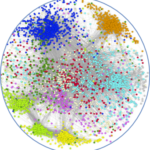Link to Pubmed [PMID] – 22022543
Link to DOI – e2614610.1371/journal.pone.0026146
PLoS One 2011 ; 6(10): e26146
Integrating gene regulatory networks (GRNs) into the classification process of DNA microarrays is an important issue in bioinformatics, both because this information has a true biological interest and because it helps in the interpretation of the final classifier. We present a method called graph-constrained discriminant analysis (gCDA), which aims to integrate the information contained in one or several GRNs into a classification procedure. We show that when the integrated graph includes erroneous information, gCDA’s performance is only slightly worse, thus showing robustness to misspecifications in the given GRNs. The gCDA framework also allows the classification process to take into account as many a priori graphs as there are classes in the dataset. The gCDA procedure was applied to simulated data and to three publicly available microarray datasets. gCDA shows very interesting performance when compared to state-of-the-art classification methods. The software package gcda, along with the real datasets that were used in this study, are available online: http://biodev.cea.fr/gcda/.


